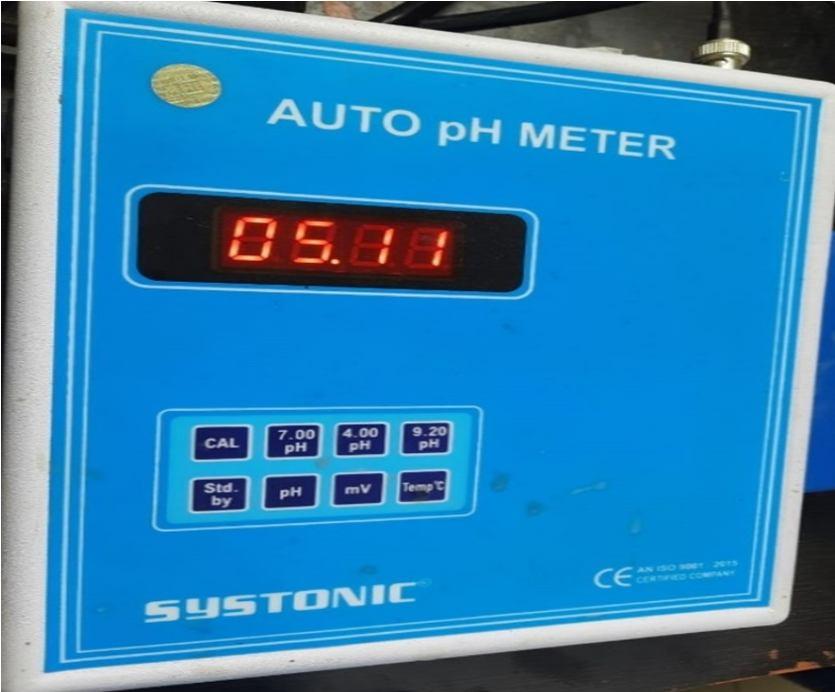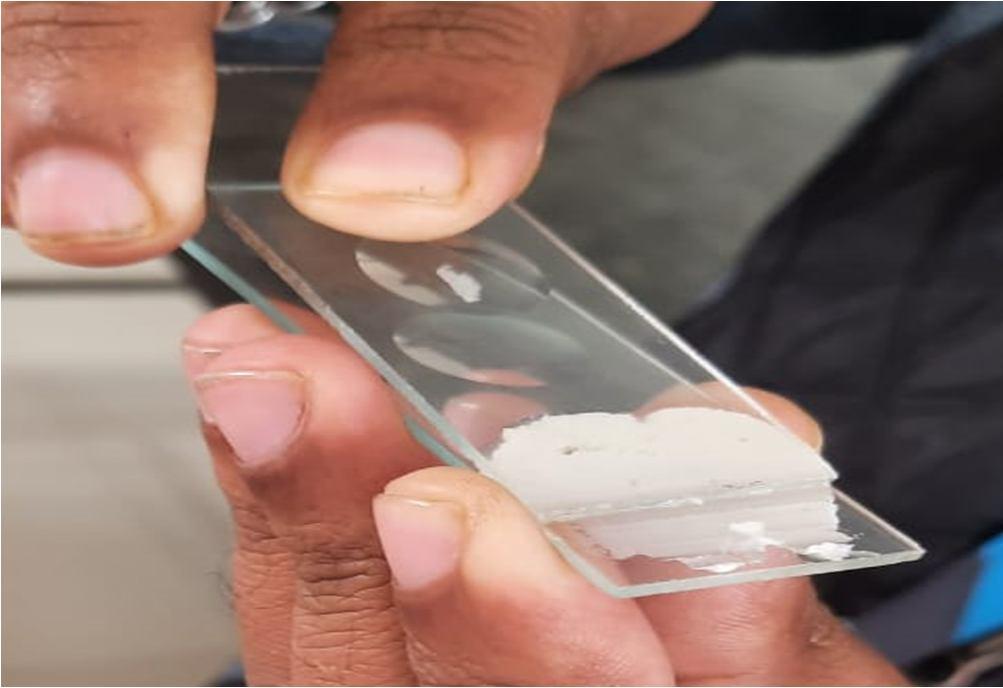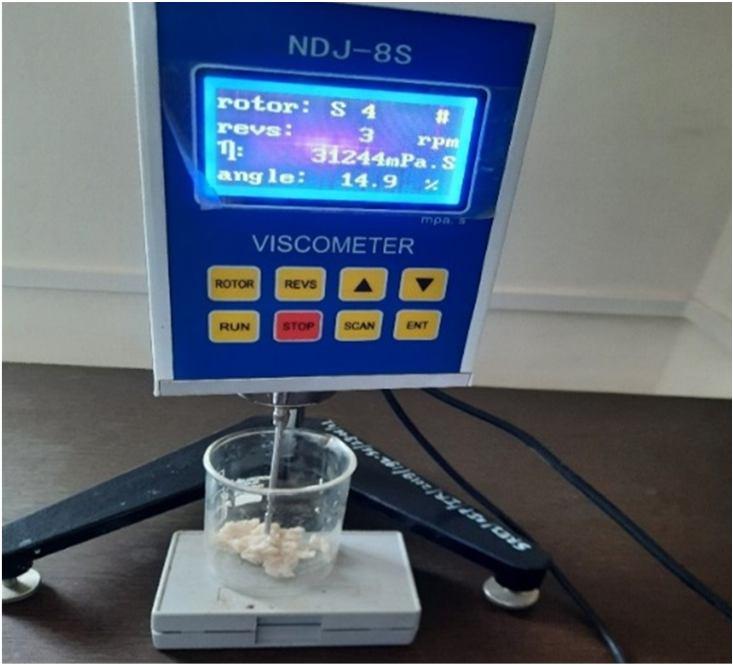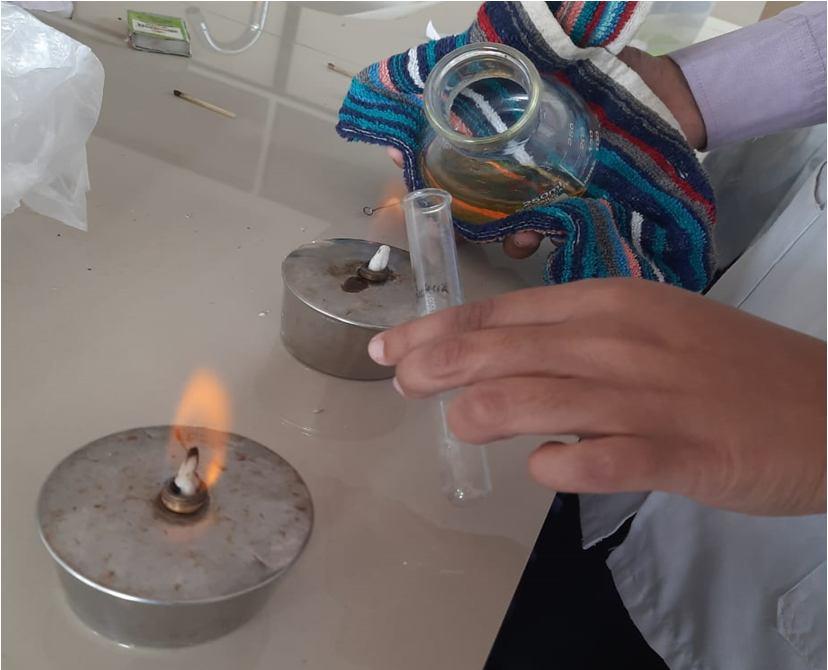
ISSN: 2321 9653; IC Value: 45.98; SJ Impact Factor: 7.538

Volume 10 Issue XI Nov 2022 Available at www.ijraset.com


ISSN: 2321 9653; IC Value: 45.98; SJ Impact Factor: 7.538

Volume 10 Issue XI Nov 2022 Available at www.ijraset.com
1
1,
2
3

4
Abstract: The plant E. Hirta and Blueberry are Famous for its medicinal importance among the tribal population. The aim of present work was to evaluate the anti acne property. Propionibacterium acnes has been recognized as pus forming bacteria causing an inflammation in acne. The study was conducted to evaluate the anti microbial activities of ethanolic extract of Euphorbia hirta and blueberry. Topical route is the most suitable route for skin diseases. The formulation of cream by combining the Euphorbia hirta and blueberry gives the activity against intradermal pathogens and also hydrates, improves complexation of skin.
We checked the parameters like Ph, Solubility, Viscosity, Moisture absorption, Shelf life, Phase separation, Spread ability and antimicrobial activity.
Keywords: Euphorbia hirta, Blueberry, Antioxidant, Microbial stability, Cosmeceutical, antibacterial, anti acne.
The main purpose of doing with this formulation to focus on problems like acne, pimples, wrinkles, rashes, ageing, etc.
Acne: It is caused block skin follicles from a plug caused by oil from a plug caused by oil from glands, bacteria and dead cells, clumped together and swell.
Cream: is a semisolid emulsion which are o/w and w/o and these semisolids emulsion is intended for external application. Cream is classified as o/w and w/o emulsion. It is applied on outer part or superficial part of skin and its main ability is to remain for long period of time at the site of application. So, in our research we prominently focus on Euphorbia hirta and blueberry extracted cream. Euphorbia hirta shows different pharmacological actions like:1) anti inflammatory, 2) anti oxidant, 3)anti tumor, 4)anti diabetic,5) anti allergic, 6)anti fungal, 7)diuric, 8)wound healing, etc. Euphorbia hirta is used to treat skin and mucous membranes problems. (Guniea, worm, scabies, trush). Euphorbia hirta passed significant activity to prevent early and late phase reaction. And also shows anti microbial activity against E. coli, Pseudomonas aeruginosa, Staphylococcus aureus. Hemophilus influenza. It is non cytotoxic.
Blueberry were first popularized as a super fruit due to man of the high in vitro antioxidant capacity of their abundant polyphenolic compound. Blueberry contain vitamins, minerals, and antioxidants that provide notable health benefits. Blueberry prevents early ageing and cancer. They are high in antioxidants that may help to protect your skin from damage and promote skin healing.
Blueberry shows different pharmacological actions like: 1) antioxidant,2) anti inflammatory,3) anti bacterial,4) anti viral,5) anti carcinogenic. Blueberry also contains salicylate, which is a salt of salicylic acid. Salicylic acid is used in the treatment of acne. It also benefits the skin greatly when applied externally and is give your skin the big beauty boost naturally.
Topical application of various blueberries has been studied to reduced wrinkle formation, ageing, dullness, minimize pores, open pores/closed pores, clean clogged pores, rejuvenate your skin. Ability to fight inflammation related to acne, psoriasis, eczema, premature ageing, improve circulation. Blueberry contains vitamin C and vitamin E which removes dullness, also prevent and heal acne.
The topical application of the combination of Euphorbia plant with blueberry fruit gives the solution for the problems which are related to the skin. The various different methods are used for the extraction of blueberry fruit and euphorbia. Along with the different parameters are also reported to check the cream of ethanolic extraction of both we used. The formulation which contain the extracted euphorbia and blueberry shows the anti microbial activity against the microorganisms which causes the dermal problems.
ISSN: 2321 9653; IC Value: 45.98; SJ Impact Factor: 7.538

Volume 10 Issue XI Nov 2022 Available at www.ijraset.com
Table no.1: Ingredient and their role Ingredients Role
Antioxidant, antifungal, anti inflammatory, antibacterial, antidiabetic, antiallergic, wound healing.
Euphorbia plant
Blueberry
Antiviral, antibacterial, anti inflammatory, antifungal, anticarcinogenic
Euphorbia hirta plants are mostly collected from the local areas of Lonimavla. Blueberries are collected from the Californian blueberries manufactured by Happilo.
Table no.2: Ingredients present in the blueberry.
Total fat 0.5g %Daily value 1%
Saturated fat (0 g) 0%
Cholesterol (0mg) 0% Sodium (0mg) 0%
Total carbohydrates (34g) 11%
Dietary Fiber (1g) 4% Sugars (27g) Protein (1g) 10%
Euphorbia hirta and blueberries are dried under the shade for 2 3 days.

1) Process for Lyophilization: Lyophilization is the process in which water is remove from the product after it is frozen. This process is carried for euphorbia plants for 3 4 days to obtained the solution. With the help of two methods, we can extract the sample.
a) Cold water treatment: Cold solution of Euphorbia hirta plant was directly pour into the porcelain dishes ad that porcelains were placed into the hot air oven for drying at 850C for 32 hrs.
b) Hot Water Treatment: Cold solution of Euphorbia hirta was heat on the water bath at 40.9 0C for 15 20 minutes, then cool and pour into the porcelain dishes and placed into the hot air oven for drying 850C for 28 hrs.
2) Process for Centrifugation: The solution which was obtained after lyophilization is centrifuged at 500 rpm by using centrifugation method. The pellet was placed into the hot air oven at 140 0C for 2 3 hours and the dried powder was obtained. With the help of two parameters the two different samples were obtained.
a) Centrifugation: Centrifugation powder
b) Hot Air Oven: Hot air oven powder
ISSN: 2321 9653; IC Value: 45.98; SJ Impact Factor: 7.538

Volume 10 Issue XI Nov 2022 Available at www.ijraset.com
Dried blueberries were directly used for extraction process.
1) Maceration: It is an extractive technique. It consists of immersing a blueberry in a water (50 ml) inside an air tight container, for a define (3 5 days) time. This process gives the blueberry solution which contain important constituents.
1) Extraction was done by using Soxhlet apparatus.
2) Extract powder of Euphorbia hirta and blueberry were obtained when it was placed in the apparatus with ethanol as a solvent.
3) By using this method, the API present in the euphorbia and blueberry were obtained and it gives the pure extract of that.
Table no.3: Components for the composition of nutrient agar. Components Quantity (g/mL) (100 ml)
Peptone 0.5 g
Yeast extract 0.2 g Sodium chloride 0.5 g Agar 1.5 g Distilled water 100 ml
The bacterial cultures were obtained from the pus of the pimples present on the face. Take a bacterial sample with the help of sterile bud and streak on the nutrient agar medium plate. This process is carried out in the aseptic conditions. After streak the microorganisms on the plate keep the plate into the incubator and incubate at 37 0C for 24 hours.
1) Gram Staining: Gram staining is a method of staining used to classify bacterial species into two large groups: gram positive bacteria and gram negative bacteria.
Methodology:
a) Take a clean, grease free slide.
b) Prepare the smear of suspension on the clean slide with a loopful of sample.
c) Airdry and heat fix.
d) Crystal violet (primary stain) was poured and kept for about 1 minute and rinse with water.
e) Flood the gram’s iodine (fixing agent) was poured and kept for about 1 minute and wash with water.
f) Then, wash with 95% alcohol or acetone for about 10 20sec. and rinse with water.
g) Add safranin for about 1 min. and wash with water.
h) Air dry and observe under microscope.
2) IMVIC test: IMVIC reactions are a set of four useful reactions that are commonly used in the identification of members of family Enterobacteriaceae. The four reactions are following:
a) Indole Test: Some bacteria can produce indole from amino acid tryptophan using the enzyme tryptophanase. Indole reacts with the aldehyde in the reagent to give a red colour.

Methodology:
Take a sterilized test tubes containing 4 ml of tryptophan broth.
Inoculate the tube aseptically by taking the growth from 18 to 24 hrs. culture.
Incubate the tube at 37 0C for 24 28 hrs.
Add 0.5 ml of Kovac’s reagent to the broth culture.
Observe for the presence or absence of ring.
ISSN: 2321 9653; IC Value: 45.98; SJ Impact Factor: 7.538

Volume 10 Issue XI Nov 2022 Available at www.ijraset.com
b) Methyl Red (MR) test: This is to detect the ability of an organism to produce and maintain stable acid end products from glucose fermentation.
Methodology:
Prepare MRVP broth in test tubes.
Inoculate the broth aseptically with 2 loopful of respective bacterial culture.
Incubate the test tubes at 37 0C for 48 72 hours.
Add few drops of methyl red indicator in the incubated tubes.
Observe the results.
c) Voges Proskauer (VP) test: VP test detects butylene glycol producers. Acetyl methyl carbinol (acetoin) is an intermediate in the production of butylene glycol.
Methodology:
Prior to inoculation, allow medium to equilibrate to room temperature.
Using organisms taken from an pure culture, lightly inoculate the medium.
Incubate aerobically at 37 0C for 24 hours.
Following 24 hrs. of incubation, aliquot 2 ml of the broth to a clean test tube.
Re incubate the remaining broth for an additional 24 hours.
Add 6 drops of 5% alpha naphthol, and mix well to aerate.
Add 2 drops of 40% potassium hydroxide, and mix well to aerate.
Observe for a pink red colour at the surface within 30 min. Shake the tube vigorously during the 30 min. period.
d) Citrate Utilization Test: This test detects the ability of an organism to utilize citrate as the sole source of Carbon and energy. The results shows change of medium’s color from green to blue.
Methodology:
Bacterial colonies are picked up from straight wire and inoculated into the Simmon’s citrate agar and incubated 24hrs. at 370C.
Observe the color change from green to blue along the media.
Components gm/lit
Peptic digest of animal tissue 5.00
Beef extract 1.50 Sodium chloride 5.00 Yeast extract 1.50
Table no.4: Components present in the nutrient broth. I. Preparation Of Cream Composition Of Cream
Table no.5: Ingredients required for formulation of cream.
Ingredients Quantity
Methyl paraben 0.2 gm

Borax 0.16 gm
Bees wax 3.2 gm
Liquid paraffin 10 ml
Perfume QS 1 2 drops Extract 5 ml
Distilled water 6 ml
ISSN: 2321 9653; IC Value: 45.98; SJ Impact Factor: 7.538

Volume 10 Issue XI Nov 2022 Available at www.ijraset.com
Take a bees wax in a porcelain dish. Add a liquid paraffin in it and warm on the water bath unto it melt and stir it with the glass rod. Keep it warm.
Other side take a borax and add into the water and melt it on water bath.
Then add the borax solution in the melted bees wax by the dropper in the warm condition and also add extract and stir continuously.
Add the methyl paraben in dish and stir continuously with magnetic stirrer up to it becomes viscous. Add 2 to 3 drops of perfume.
Evaluation of cream was following:
a) Colour: The color of cream was observed by visual examination. The result was shown in below table.
b) Odour: The odour of cream was found to be characteristics.
c) State: The state of cream was examined visually. The state of cream was shown in the table below.
d) Consistency: The formation was examined by rubbing the cream on hand manually. The cream having smooth consistency.
e) Ph: The Ph of a cream was determined by using digital ph meter with the standard ph solutions. The solution of cream was taken for the ph. determination. Result was shown in table below.
f) Spread Ability: The spread ability of cream was measured by placing the cream sample on the slide and spread with the help of other slide, it spread uniformly.
g) Moisture Absorption Studies: About 50 mg of cream was taken on the slide. A beaker was taken with the full of water and was kept in a desiccator without absorbents. Slide with cream was introduced into the desiccator. It was left for 24 hrs. The result is shown below.
h) Viscosity: The viscosity of cream was determined using Brookfield viscometer at the temperature 25 0C using the spindle no.4. The result was shown in table.
i) Phase Separation: The formulated cream was kept intact in a closed container at 25 30 0C not exposed to light. The phase separation was observed carefully every 24 hrs. for 30 days. Any change in phase separation was checked. The is given below in the table.
Sterility testing is a quality control test for any sterile product, required for all articles or substances. This was done to detect if viable forms of micro organisms are present or not on or in the pharmaceutical preparations.
Methodology:
The nutrient agar medium was prepared in petri plates. The formulated cream was spread on the nutrient agar medium in the petri plate by using the nichrome wire loop. This process was done by the spread plate method and in the aseptic condition. The plates were placed in the incubator at 37 0C for 24 hrs. After 24 hrs. incubation the no growth any organisms were observed.
Anti microbial activity:
To perform the anti microbial activity of the formulated cream we were used the broth dilution method. Broth dilution method is the method used for the anti microbial activity in which the bacteria are inoculated into a liquid medium in the presence of different concentration of a formulated cram as a anti microbial agent. The growth is assessed after incubation for a defined period of time (24 48hrs.).

Experimental methodology:
To perform the method, take 2.4g of nutrient broth in the conical flask.
Add the 100ml of distilled water in it. And mix slowly.
Take a test tubes and nutrient broth medium and autoclave it for 15 min at 1210C at 15 psi.
Then cool thenutrient broth and in the test tubes in equal quantity. This process was done in a aseptic condition.
Take a bacterial culture which was grown in a nutrient agar medium petri plate and add the microorganisms with the help of nichrome wire loop and mix well.
ISSN: 2321 9653; IC Value: 45.98; SJ Impact Factor: 7.538

Volume 10 Issue XI Nov 2022 Available at www.ijraset.com
Take a formulated cream and add in the test tube in which the microorganisms were added.
Mix the cream well. And repeated this procedure for all the test tubes.

Then the test tubes were kept in the incubator at 370C for 24 hrs.

After 24 hrs. the broth medium in the test were checked














ISSN: 2321 9653; IC Value: 45.98; SJ Impact Factor: 7.538
Volume 10 Issue XI Nov 2022 Available at www.ijraset.com
Maceration process was carried out for the blueberry. The blueberry soaked in the water for 3 to 7 days in a closed air tight container.


Extraction procedure of Euphorbia hirta and blueberry was done by using the Soxhlet apparatus.

Figure 10 Soxhlet apparatus for the extraction of blueberry and euphorbia hirta
The preparation of nutrient agar plate required nutrient broth and agar. It mixed with distilled water and autoclave it and Petri plates at 15 psi for 15 min at 121 0C. Then cool it and pour into Petri plate in aseptic condition.

ISSN: 2321 9653; IC Value: 45.98; SJ Impact Factor: 7.538 Volume 10 Issue XI Nov 2022 Available at www.ijraset.com




The bacterial culture was obtained from the acne or pus from the skin. The bacterial culture was inoculated in the nutrient agar medium plates.
Figure12 a) Bacterial culture from the pimples By the sterile bud b) The bacterial culture inoculated on the nutrient agar medium plate after Incubation for 24 hrs. at 37 0C.

Gram staining of bacterial culture was done.
Figure 13 Gram staining of bacterial culture

ISSN: 2321 9653; IC Value: 45.98; SJ Impact Factor: 7.538

Volume 10 Issue XI Nov 2022 Available at www.ijraset.com




ISSN: 2321 9653; IC Value: 45.98; SJ Impact Factor: 7.538 Volume 10 Issue XI Nov 2022 Available at www.ijraset.com


The Ph of formulated cream was done by using pH meter.





Spread ability of formulated cream was done by using the spread ability test by using the slides.
Figure 16 The spread ability of formulated cream.
ISSN: 2321 9653; IC Value: 45.98; SJ Impact Factor: 7.538 Volume 10 Issue XI Nov 2022 Available at www.ijraset.com

Viscosity of formulated cream was evaluated by Brookfield viscometer.


Figure 18 The determination of viscosity of formulated cream.



The sterility testing of formulated cream was done successfully by spreading the cream on nutrient agar medium plate and incubate it for 24 hrs. at 37 0C.
Figure 19 a)The spreading of cream on nutrient agar plate b) after the incubation for 24 hrs. at 37 0C.

ISSN: 2321 9653; IC Value: 45.98; SJ Impact Factor: 7.538 Volume 10 Issue XI Nov 2022 Available at www.ijraset.com






The anti microbial activity of formulated cream was done by using the broth dilution method.
ISSN: 2321 9653; IC Value: 45.98; SJ Impact Factor: 7.538 Volume 10 Issue XI Nov 2022 Available at www.ijraset.com


The present study revealed that ethanolic extract (bySoxhlet apparatus. Fig no.10) of euphorbia hirta whole plant and blueberry fruit that improves anti acne property after topical application. Euphorbia hirta have interesting pharmacological activity which are discovered like anti diabetic, antitumor, antifungal, antioxidant, antimicrobial, antifungal, anti inflammatory, and anti allergic The blueberry fruit is rich source of potent phenolic antioxidant and it contains the dietary fiber. They are the rich source of folic acid, calcium, vitamin C and E which helps to improves eyesight, helps in anti ageing and improves cardiovascular health. It also shows anti bacterial, anti inflammatory, anti fungal, anti carcinogenic activities. The ethanolic extract (Soxhlet) of euphorbia hirta and blueberry exhibited strong anti microbial, anti oxidant and anti acne activity. Euphorbia hirta taken by orally, it can cause some side effects such as nausea and vomiting. It can cause skin irritation or allergic reaction. In present work ethanolic extract of euphorbia hirta and blueberry shoes strong anti microbial, anti acne, anti fungal, anti allergic, anti inflammatory and anti oxidant activity. Propionibacterium acnes has been recognized as pus forming bacteria causing inflammation on an acne. The results of different tests of cream showed that the formation could be used topically in order to protect skin against damage. The observed potential anti bacterial activity of formulations may be due to the presence of active constituents in the ethanolic extract of euphorbia hirta and blueberry. The anti bacterial activity was well maintained when it was converted into cream formulation. In this article is prominently discuss the anti acne property of combination of euphorbia hirta and blueberry. In this study, the potent anti acne property of euphorbia hirta and blueberry extract was reported. The extract clearly demonstrated that the extract has ability to inhibit acne causing bacteria. In this article we conclude the pharmacological activity of extraction of euphorbia hirta and blueberry on lab scale in the in vitro condition. In future we have to check the pharmacological activity or anti acne property of extracted euphorbia hirta and blueberry in in vivo condition. FT IR spectroscopy is often used in future to identify the functional groups within a molecule and it is used to determine the quantitatively concentrations of molecules within a sample. NMR spectroscopy is also be used in future to determine a chemical structure of a molecules present in the extract.
In this article we collect and dry the euhorbia hirta and blueberry fruits. The extract of euphorbia hirta is obtain by lyophilization process, after that we do the cold and hot water treatment and dried powdered is obtain (refer fig. no. 1 7). The other side blueberry is isolated with the help of maceration (refer fig.no.9). Then we extract the euphorbia hirta and blueberry by the Soxhlet apparatus using ethanol as a solvent. The euphorbia hirta have no any application for the dermal treatment. In the combination with blueberry, it shows strong activity against the acne causing bacteria. So, we make the cream formulation of extraction of euphorbia hirta and blueberry by using the formula given in the table no.5(refer fig.no.14). and the extract is added 10 ml in it. The cream of extraction of euphorbia hirta and blueberry passed all the parameter testing which is given in the table no.8(refer fig.no.15 19). The formulated cream passed the sterility test (refer fig.no.19) and has the ideal ph. value which is required for the skin. The formulated cream is highly stable at room temperature and it does not change its appearance and texture due to any environmental factors. We checked the anti microbial activity of cream by taking the pimple pus sample in which the gram positive and gram negative bacteria are present. The anti microbial activity is done by using broth dilution method which shows the

ISSN: 2321 9653; IC Value: 45.98; SJ Impact Factor: 7.538 Volume 10 Issue XI Nov 2022 Available at www.ijraset.com
formulated cream shows high anti microbial and anti acne activity. After 24 48 hrs. of incubation the test tube containing solution is very clear and it is same as before the inoculation, there is no growth of any microorganism (refer fig.no.20). So, in this article we shows anti microbial and anti acne activity of the formulated cream which is contain extract(Soxhlet) of euphorbia hirta and blueberry
[1] Al Snafi AE. Medicinal plants with antimicrobial activities (part 2): Plant based review. Sch Acad J Pharm 2016; 5(6): 208 239. http://saspublisher.com/wp content/uploads/2016/07/SAJP 56208 239.pdf
[2] Ping KY, Darah I, Chen Y, Sreeramanan S and Sasidharan S. Acute and subchronic toxicity study of Euphorbia hirta L. methanol extract in rats. Hindawi Publishing Corporation BioMed Research International 2013, http://dx.doi.org/10.1155/2013/ 182064
[3] Raimundo, A.F.; Félix, F.; Andrade, R.; García Conesa, M.T.; González Sarrías, A.; Gilsa Lopes, J.; do Ó, D.; Raimundo, A.; Ribeiro, R.; Rodriguez Mateos, A.; et al. Combined effect of interventions with pure or enriched mixtures of (poly)phenols and anti diabetic medication in type 2 diabetes management: A meta analysis of randomized controlled human trials. Eur. J. Nutr. 2020, 59, 1329 1343.
[4] N. Abdullah, N.L. Chin Simplex centroid mixture formulation for optimized composting of kitchen waste Bioresource Technol., 101 (21) (2010), pp. 8205 8210, 10.1016/j.biortech.2010.05.068
[5] Sannia Farooque, Paul M. Rose, Meryem Benohoud, Richard S. Blackburn, Christopher M. Rayner Enhancing the Potential Exploitation of Food Waste: Extraction, Purification, and Characterization of Renewable Specialty Chemicals from Blackcurrants (Ribes nigrum L.). Journal of Agricultural and Food Chemistry 2018, 66 (46) , 12265 12273.

[6] Mathur A, Dixit VP, Dobal MP. Antifertility plant product: Euphorbia hirta in males. Proceedings of the International Symposium on Male Contraception: Present and Future. 1995

[7] Moretti, G. , Rebora, A , Guarrera, M. Striae Distensae: how and why they are formed. Striae Distensae (G. Moretti and A. Rebora, eds), pp. 30 48. Brodcades, Milan (1976).
[8] Emencheta SC, Enweani IB, Oli AN, Okezie UM, Attama AA. Evaluation of antimicrobial activities of fractions of plant parts of Pterocarpus santalinoides Biotechnol J Int. 2019; 23(3):1 11.
[9] Bhatia L, Bishnoi H, Chauhan P, Kinja K, Shailesh S. In vitro comparative antioxidant activity of ethanolic extracts of glycosmis pentaphylla and bauhinia variegate. Recent Res Sci Technol. 2011;3:01 3.
[10] Tim T.P., Cushnie, Andrew J. Lamb., Errata for “Antimicrobial activity of flavonoids, International Journal of Antimicrobial Agents, 2006, 27(2), 181.
[11] Mishra AK, Mishra A, Chattopadhyay P. Herbal Cosmeceuticals for Photoprotection from Ultraviolet B Radiation: A Review. Tropical Journal of Pharmaceutical Research. 2011; 10(3): 351 360.
[12] Aghel N, Moghimipour E, Ameri A (2007). Characterization of an antidermatophyte cream from Zataria multiflora Boiss. Iranian J. Pharm. Sci. 3:77 84.
[13] Leyden J.J., Current issues in antimicrobial therapy for the treatment of acne, J Eur Dermatol Venereol, 2001, 15(3), 51 55.
[14] Hsieh MF, Chen CH. Review: Delivery of pharmaceutical agents to treat acne vulgaris: current status and perspectives. J Med Biol Eng. 2011;32(4):215 24. http://dx.doi.org/10.5405/jmbe.901 .
[15] Clinical and Laboratory Standards Institute. Performance standards for antimicrobial susceptibility testing; sixteenth informational supplement. CLSI document M100 S16CLSI, Wayne, PA (2006).
